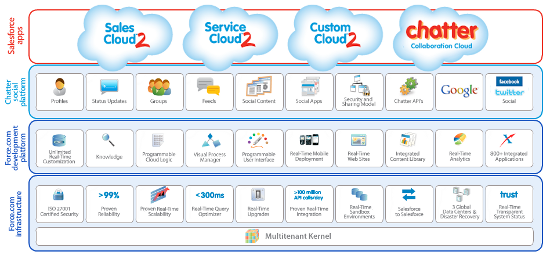The future of business collaboration is in web-based social networks, and software vendors of all stripes are all stampeding to gain mindshare in this space.
For example, IBM has LotusLive, Microsoft has their Azure platform, and Google has Google Apps.
And at a media event today, Salesforce.com folks talked about their upcoming launch of Chatter, yet another Facebook-like social networking collaboration platform, this time for their Salesforce.com customer base.
According to Jeremy Cooper, Asia Pacific’s regional VP for marketing at Salesforce.com, Chatter will be live by the middle of this year. It was announced last year in November 2009, and is currently already available for developers in a private beta. I’ll let their Chatter YouTube video explain what it is all about:
Social networking, all grown up
We are moving towards a world where social networks is seen as a legitimate enterprise productivity tool, and not just a fun consumer fad.
Companies like Salesforce.com realize that social networking is not just about Facebook games and inane celebrity “Oh My Gawd!” twitter posts — there’s real money to be made, and real value to be derived from social networks.
I don’t know if there is a charging model for Chatter — we’ll probably get details of this only when it launches — but Salesforce.com believes that Chatter brings value to their existing customer base. For example, rather than having long email chains, you can use a Facebook-like interface to communicate project updates to various groups. It’s sorta like Lotus Connections or Microsoft’s Sharepoint, but run on a cloud-based model.
With Salesforce.com’s roots as a SaaS (software as a Service) business software vendor, where software is purchased via subscription and hosted offsite, adding a social networking component to their cloud-based platform is, in many ways, a logical step for them to take.

Battle lines drawn
Of course, adding social networking tools is a very different thing from having a sizeable community using that platform. Facebook has about 400 million users, and IBM’s LotusLive has about 18 million users. Contrast that to Salesforce.com’s two million users.
Scale really does mean something in this game. The bigger you are, the more people you can reach, obviously.
Adding social network tools to keep existing customers entrenched on your platform is a smart move to make, but even better would be to work with other social networks and share information to grow your own platform and user base.
At least in an ideal world, from an end-user perspective, vendors will all happily federate their networks. But it ain’t going to happen anytime soon.
Meanwhile, vendors in this social networking market — especially the smaller ones –are banding together to carve out their own territory. For example, Salesforce.com is also working with IBM on their LotusLive platform, and LinkedIn is working with both Microsoft (Outlook Social Connector) and IBM (LotusLive).
But what of the original innovators in this space, like Facebook and Twitter?
I had a chat with Michael Barns, vice president of software and Asia Pacific research at Springboard Research, today at the event, and his comments on Facebook and Twitter were insightful.
He’s surprised that Facebook and Twitter haven’t moved into the enterprise space yet. “Social networks let us not only interact with family and friends, but with colleagues as well,” he said.
And with companies like IBM (e.g. LotusLive and IBM’s project Vulcan) and Google (e.g. Google Buzz and Google Wave) throwing lots of money into this area, it’s definitely a threat to the original innovators and incumbents in this space.
Perhaps Facebook should take a leaf from Google. We all know Google makes a fortune on advertising. But there’s money to be made in enterprise versions of free consumer stuff as well like Google Apps for businesses.





CONTEXT brings new dimension to enterprise 2.0 , social network collaboration within business environment gives more freedom for the enterprise challenges to integrate business application with facebook and twitter like applications. it is good to watch new ideas emerge that complement salesforce chatter and share point.